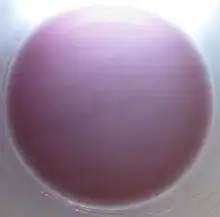Solubility of fullerenes
The solubility of fullerenes is generally low. Carbon disulfide dissolves 8g/L of C60, and the best solvent (1-chloronaphthalene) dissolves 53 g/L. up Still, fullerenes are the only known allotrope of carbon that can be dissolved in common solvents at room temperature. Besides those two, good solvents for fullerenes include 1,2-dichlorobenzene, toluene, p-xylene, and 1,2,3-tribromopropane. Fullerenes are highly insoluble in water, and practically insoluble in methanol.

60 in solution

60 in extra virgin olive oil showing the characteristic purple color of pristine C
60 solutions
Solutions of pure C60 (buckminsterfullerene) have a deep purple color. Solutions of C70 are reddish brown. Larger fullerenes C
76 to C
84 have a variety of colors. C
76 has two optical forms, while other larger fullerenes have several structural isomers.
General considerations
Some fullerene structures are not soluble because they have a small band gap between the ground and excited states. These include the small fullerenes C
28,[1] C
36 and C
50. The C
72 structure is also in this class, but the endohedral version with a trapped lanthanide-group atom is soluble due to the interaction of the metal atom and the electronic states of the fullerene. Researchers had originally been puzzled by C
72 being absent in fullerene plasma-generated soot extract, but found in endohedral samples. Small band gap fullerenes are highly reactive and bind to other fullerenes or to soot particles.
Solubility of C
60 in some solvents shows unusual behaviour due to existence of solvate phases (analogues of crystallohydrates). For example, solubility of C
60 in benzene solution shows maximum at about 313 K. Crystallization from benzene solution at temperatures below maximum results in formation of triclinic solid solvate with four benzene molecules C
60·4C
6H6 which is rather unstable in air. Out of solution, this structure decomposes into usual face-centered cubic (fcc) C
60 in few minutes' time. At temperatures above solubility maximum the solvate is not stable even when immersed in saturated solution and melts with formation of fcc C
60. Crystallization at temperatures above the solubility maximum results in formation of pure fcc C
60. Millimeter-sized crystals of C
60 and C
70 can be grown from solution both for solvates and for pure fullerenes.[2][3]
Solubility table
The following are some solubility values for C
60 and C
70 from the literature, in grams per liter.[4][5][6][7][8]
| Solvent | C 60 |
C 70 |
|---|---|---|
| 1-chloronaphthalene | 51 | ND |
| 1-methylnaphthalene | 33 | ND |
| 1,2-dichlorobenzene | 24 | 36.2 |
| 1,2,4-trimethylbenzene | 18 | ND |
| tetrahydronaphthalene | 16 | ND |
| carbon disulfide | 8 | 9.875 |
| 1,2,3-tribromopropane | 8 | ND |
| chlorobenzene | 7 | ND |
| p-xylene | 5 | 3.985 |
| bromoform | 5 | ND |
| cumene | 4 | ND |
| toluene | 3 | 1.406 |
| benzene | 1.5 | 1.3 |
| carbon tetrachloride | 0.447 | 0.121 |
| chloroform | 0.25 | ND |
| n-hexane | 0.046 | 0.013 |
| cyclohexane | 0.035 | 0.08 |
| tetrahydrofuran | 0.006 | ND |
| acetonitrile | 0.004 | ND |
| methanol | 4.0×10−5 | ND |
| water | 1.3×10−11 | ND |
| pentane | 0.004 | 0.002 |
| heptane | ND | 0.047 |
| octane | 0.025 | 0.042 |
| isooctane | 0.026 | ND |
| decane | 0.070 | 0.053 |
| dodecane | 0.091 | 0.098 |
| tetradecane | 0.126 | ND |
| acetone | ND | 0.0019 |
| isopropanol | ND | 0.0021 |
| dioxane | 0.0041 | ND |
| mesitylene | 0.997 | 1.472 |
| dichloromethane | 0.254 | 0.080 |
| ND = not determined | ||
See also
References
- Guo, T.; Smalley, R.E.; Scuseria, G.E. (1993). "Ab initio theoretical predictions of C
28, C
28H4, C
28F4, (Ti@C
28)H4, and M@C
28 (M = Mg, Al, Si, S, Ca, Sc, Ti, Ge, Zr, and Sn)". Journal of Chemical Physics. 99 (1): 352. Bibcode:1993JChPh..99..352G. doi:10.1063/1.465758. - Talyzin, A.V. (1997). "Phase Transition C
60−C
60*4C
6H6 in Liquid Benzene". Journal of Physical Chemistry B. 101 (47): 9679–9681. doi:10.1021/jp9720303. - Talyzin, A.V.; Engström, I. (1998). "C
70 in Benzene, Hexane, and Toluene Solutions". Journal of Physical Chemistry B. 102 (34): 6477–6481. doi:10.1021/jp9815255. - Beck, Mihály T.; Mándi, Géza (1997). "Solubility of C
60". Fullerenes, Nanotubes and Carbon Nanostructures. 5 (2): 291–310. doi:10.1080/15363839708011993. - Bezmel'nitsyn, V.N.; Eletskii, A.V.; Okun', M.V. (1998). "Fullerenes in solutions". Physics-Uspekhi. 41 (11): 1091–1114. Bibcode:1998PhyU...41.1091B. doi:10.1070/PU1998v041n11ABEH000502.
- Ruoff, R.S.; Tse, Doris S.; Malhotra, Ripudaman; Lorents, Donald C. (1993). "Solubility of fullerene (C
60) in a variety of solvents" (PDF). Journal of Physical Chemistry. 97 (13): 3379–3383. doi:10.1021/j100115a049. - Sivaraman, N.; Dhamodaran, R.; Kaliappan, I.; Srinivasan, T. G.; Vasudeva Rao, P. R. P.; Mathews, C. K. C. (1994). "Solubility of C
70 in Organic Solvents". Fullerene Science and Technology. 2 (3): 233–246. doi:10.1080/15363839408009549. - Semenov, K. N.; Charykov, N. A.; Keskinov, V. A.; Piartman, A. K.; Blokhin, A. A.; Kopyrin, A. A. (2010). "Solubility of Light Fullerenes in Organic Solvents". Journal of Chemical & Engineering Data. 55: 13–36. doi:10.1021/je900296s.